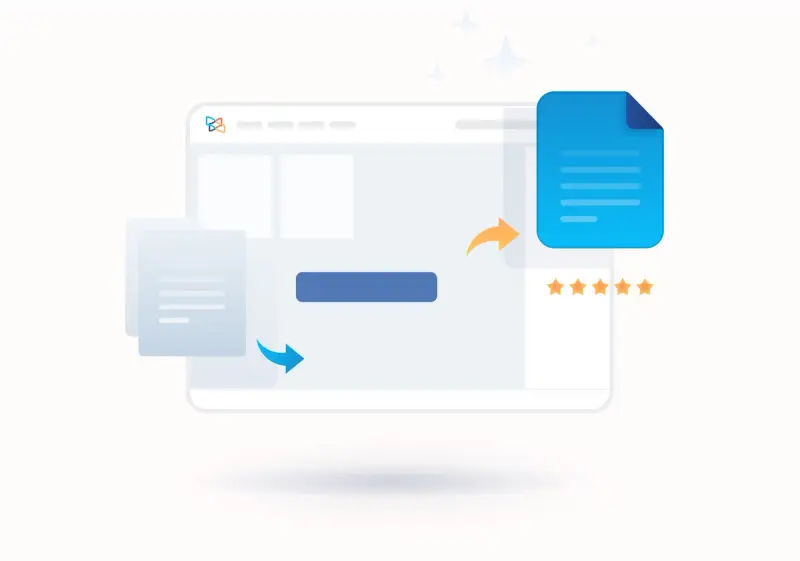Your Guide to Leveraging PDF/A for Compliance and Preservation
By Valerie Yates, Roger Dunham | 2024 Feb 28

8 min
Tags
explainer
conversion
pdf/a
This blog provides answers to all your common PDF/A questions. Learn about the difference between PDF and PDF/A, PDF/A conversion options for business users and developers, validating PDF/A files, and much more.
If you need to convert to PDF/A today, check out information about our PDF/A conversion options, as well as our guides on how to convert to PDF/A programmatically (with code) and via an easy-to-use command-line utility.
You may also want to read our guides on types of PDF/A variants you can convert to. For most cases, we recommend PDF/A-2b. You can also read about the different PDF/A versions.
Read on for answers to other PDF/A FAQs!
What's the Difference between PDF and PDF/A?
Many of us are familiar with Portable Document Format (PDF) and use PDF documents frequently. But what is PDF/A, and why did this variant come to be?
What Is PDF?
PDF, which stands for Portable Document Format, is the world’s most used format for ensuring that a document appears consistently for all viewers, regardless of the system used to create, view, or store it.
A PDF can contain diverse content, such as dynamic objects, metadata, links, images, audio, and more. This content, however, makes PDF less than ideal for long-term document archiving. Why? Because over time, links break, and embedded media becomes unsupported, making a document unusable. Some elements in a PDF may not be embedded (for example, fonts), relying instead on viewing systems to substitute fonts and render color profiles. This affects the portability of a PDF, for the original document will not display consistently for all viewers.
What Is PDF/A?
PDF/A is an ISO-standardized, archival format PDF intended for the long-term preservation of electronic documents. Unlike PDF, PDF/A prohibits features unsuitable for long-term archiving, such as non-embedded fonts, encryption, certain types of compression, and more.
PDF/A is 100% self-contained - all the information necessary for the consistent display of a document is embedded in the file instead of relying on external sources.
The result? An archival version of a document renders the same as when the document was saved, preserving it for the long term regardless of technological changes.
Ensure Legal Compliance and Secure Your Documents - Discover the Benefits of PDF/A and Digital Signatures
Are There PDF/A Types?
There are four PDF/A standards (PDF/A-1, -2, -3 and -4) and associated PDF/A conformance levels (a, b, and u, plus 4e and 4f).
For PDF/A -1, -2 and -3, level A conformance meets all requirements for the standard. Level B is the easiest conformance level to target while ensuring reliable rendering.
Check out our blog for a deep technical dive into PDF/A standards and conformance levels.
What Is PDF/A Compliance?
A PDF/A compliant file meets the requirements of the PDF/A standard. Some requirements prohibit certain functions that could hinder long-term archiving, while others guarantee reliable reproduction.
Minimum requirements include:
- All content must be embedded (fonts, colors, text, images, etc.) and must not reference external content
- The file does not contain audio or video (unless PDF/A-4f)
- The file does not contain JavaScript
- The files does not use LZW compression
- The file is not encrypted or password protected
- Metadata in the file is encoded using Extensible Metadata Platform (XMP) technology
- The file does not use XFA forms
- Interactive form fields must have an appearance dictionary
Who Uses PDF/A and Why?
PDF/A is accepted as the international standard (ISO 19005-1) for electronic archiving. Organizations prefer PDF/A over other archiving formats, such as TIFF, because of PDF/A’s international acceptance and ability to preserve interactive text and formatting, searchability, vector graphics, raster images, and metadata.
- The US Supreme Court requires documents submitted through electronic filing to be in PDF/A.
- In the EU, PDF/A is recommended or legislated for archiving in various organizations and governments.
How Is PDF/A Used?
Organizations digitize and archive documents using PDF/A for different reasons:
Compliance
Governments and legal firms can convert all their legal documents to PDF/A for archiving and compliance purposes. As a bonus, digital signatures in a PDF/A document are legally binding.
Productivity
Banks, insurance companies, or healthcare providers can archive terms of service, invoices, or letters to enable searchability for enhanced service and productivity.
Automation
Libraries, newspaper agencies, and government institutions use PDF/A tools to automate archiving in high-throughput web applications of server-based environments.
For large collections of existing PDF documents, PDF/A tools used in batch mode ensure all files are suitable for long-term archiving.
Collaboration
Workers in architecture, engineering, and construction share versions of technical drawings and archive final plans for long-term accessibility.
Accessibility
In the US, the federal government uses PDF/A to satisfy 508 compliance requirements of the Americans with Disabilities Act (ADA).
How Do I Convert from PDF to PDF/A?
There are many options for converting from PDF to PDF/A. Apryse offers three options to match your requirements:
- An online PDF/A converter tool that will let you create a small amount of PDF/A, one at a time, for free.
- A PDF/A library to embed a conversion API into any application, for high-throughput environments.
- A self-contained command-line tool for easy conversion and validation.
Option 1: XODO Online PDF/A Converter
To convert just a couple of PDFs, look no further than Apryse’s freemium online PDF/A converter tool. Registration is not required, and our service works on all devices, on macOS, Windows, Linux, iOS, and Android. Files are private and automatically deleted after 48 hours.

Option 2: Embed a High-Throughput PDF/A Conversion API
If you’re working with repositories of thousands of files, you need to convert to PDF/A as easily as possible, with automation and batch conversion on your side.
You can integrate high-throughput PDF to PDF/A conversion into an internal workflow or commercial application. Apryse offers a PDF/A Library to enable PDF/A conversion and validation on Windows, Linux, or macOS.
To get started, download a trial of the Apryse PDF/A Library for converting 20+ file formats to any of the PDF/A variants. Check out the PDF/A conversion how-to guide for get-started steps and samples in your language of choice. You can also look at the PDF/A Library documentation.
Using JavaScript & WebAssembly, Apryse even lets you convert to and validate PDF/A purely client-side via a browser. Find samples on how to add PDF/A conversion to a web application.
The component produces an XML report for each conversion. Use this to automate document processing—or open it in a web browser to see errors found during conversion and to access links to successfully converted files.
Option 3: Convert with PDF/A Manager CLI
For off-the-shelf conversion, we also offer the command-line tool PDF/A Manager. PDF/A Manager is a specialized, self-contained component that provides a fast and reliable way to convert PDF and produce valid PDF/A files. Deploy it to your device to try converting in batches today.
- Find PDF/A Manager in the tools & utilities download center.
PDF/A Manager contains two options that support:
- Conversion – to identify non-compliant PDF elements and automatically fix issues so your PDF/As pass validation
- Validation – to ensure you have PDF/As that comply with the PDF/A specification
Both options produce XML reports so you can see which files and elements didn’t pass and easily access successfully converted files.
Learn more in the PDF/A Manager documentation.
Is PDF/A Validation Necessary?
PDF/A validation ensures you have PDF/As that comply with the PDF/A specification. At a minimum, you’ll perform validation:
- As part of creating a PDF/A file
- Before placing a PDF/A into a digital archive
Validation tests may be required during other points of a PDF/A file lifecycle as required by your business processes.
Do All PDF/A Validators Perform Equally Well?
Different PDF/A validation tools perform varying levels of validation, impacting the ability of your PDF/As to validate in other PDF/A tools.
Some desktop tools provide a best guess about PDF/A compliance. This type of check isn't the same as a formal validation test.
A professional PDF/A validator tool provides conformance verification and PDF/A validation, as well as a report for each tested document. Validation provides peace of mind that you’re archiving compliant files and thus ensures the highest technical quality of your business documents.
Who Validates the Validators?
A reliable PDF/A validator needs testing to ensure consistent validation results that align with those of other PDF/A validators.
Apryse tools are tested extensively against veraPDF validation — veraPDF is an open-source PDF/A validator supported by the PDF industry, led by the Open Preservation Foundation, and funded by the EU. Using a veraPDF-aligned validator ensures the highest probability of consistent validation results across other PDF/A tools and thus also the highest possibility of preservation for the long term.
Even More Answers to PDF/A FAQs
Q: Do I have to purchase an application to view PDF/A Files?
No. All PDF viewers can display PDF/A files. Free viewers are widely available on virtually all computing devices.
Q: Are there compliant alternatives to PDF/A?
No. Tag Image File Format (TIFF), MS Word, and JPEG are not ISO standards for archiving.
Q: Can I embed video or audio objects?
It depends in the version. This is possible in PDF/A-4f but other compliance levels prohibit the use of audio and video objects in PDF/A files.
Q: Can I embed CAD files in PDF/A files?
Yes. PDF/A-3 files can include CAD files as embedded objects.
Q: Can PDF/A files be encrypted?
No. PDF/A prohibits the use of encryption on a file.
Q: Does PDF/A allow compression?
Yes. ZIP file compression is permitted, and images can be compressed using JPEG compression. LZW compression is not permitted.
Q: Are PDF/A files bigger than PDF files?
A PDF/A file might be slightly larger than the source PDF file, particularly if fonts were not embedded in the source file. More information might be stored in metadata and some color profiles might result in a larger file size.
Q: Can PDF/A contain metadata?
Yes. PDF/A allows users to save metadata (for example, copyright and custom namespace properties) in a document using Extensible Metadata Platform (XMP) technology.
Q: Can all fonts be embedded in PDF/A files?
For the most part. Some fonts are not licensed for embedding in a PDF document, so you can’t subset characters from those fonts.
Q: Can PDF/A contain bookmarks?
Yes. Bookmarks are permitted in PDF/A.
Q: Can PDF/A documents be "accessible"?
Yes. PDF/A files may conform to PDF/UA, the ISO standard for accessible PDF technology.
Q: Can PDF/A contain annotations and notes?
Yes. PDF/A permits most forms of PDF annotations. All annotations must be visible.
Q: Will future developments to the PDF/A standard make current PDF/A versions obsolete?
No. The ISO standard requires that PDF viewers be backward compatible to correctly display older versions of PDF/A.
In Conclusion
Apryse offers a suite of PDF/A converters to match the level of developer resources available to you, your language of choice, and conversion needs – from a few conversions online, to high throughput in a server environment, to client side in a secure web application. The following options are available:
- Apryse’s free online PDF/A converter tool to convert a couple of files
- The Apryse PDF/A Library to convert to PDF/A programmatically in any application
- The easy-to-use, off-the-shelf command-line converter tool PDF/A Manager, included in the PDF/A Library
If you have any questions about Apryse’s PDF SDK or PDF/A, feel free to get in touch!
This article was originally published in Oct 2022.
Tags
explainer
conversion
pdf/a

Valerie Yates
Sr. Content Strategist

Roger Dunham
Related Products
Share this post


